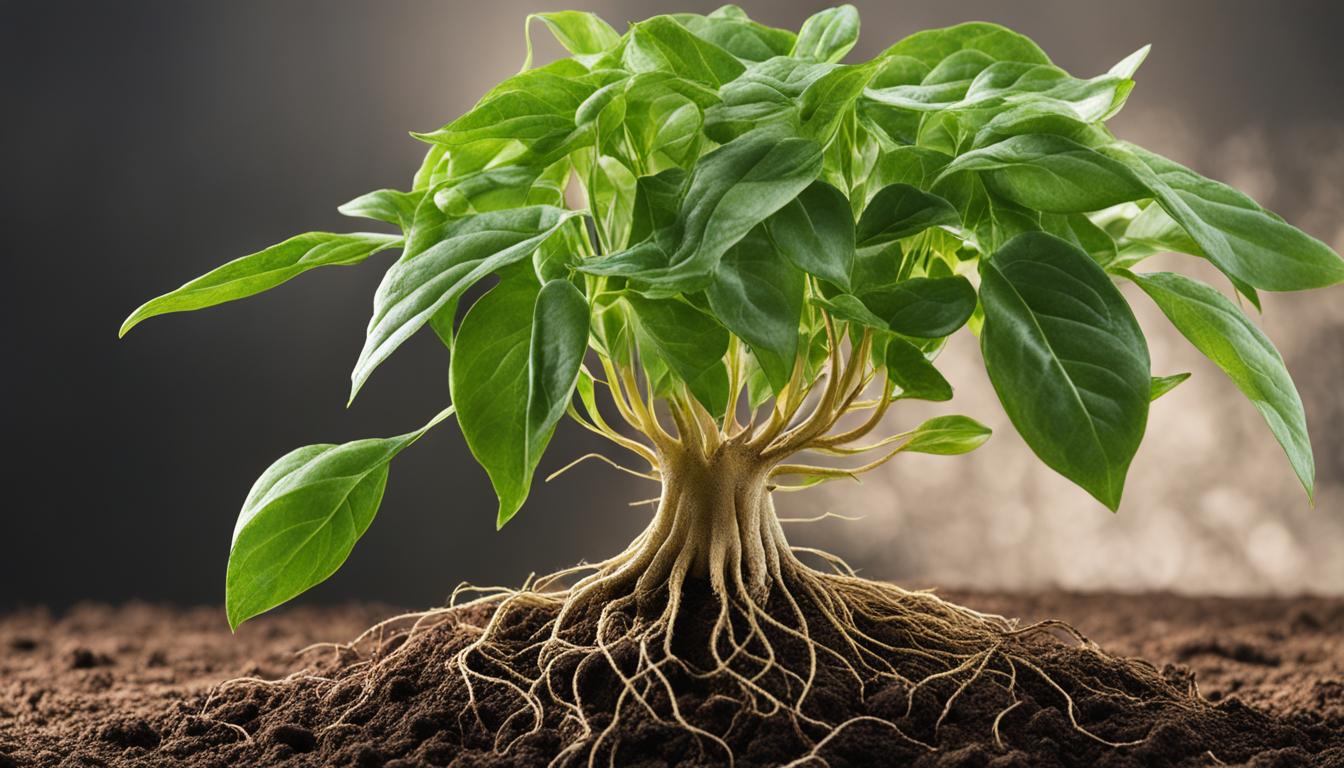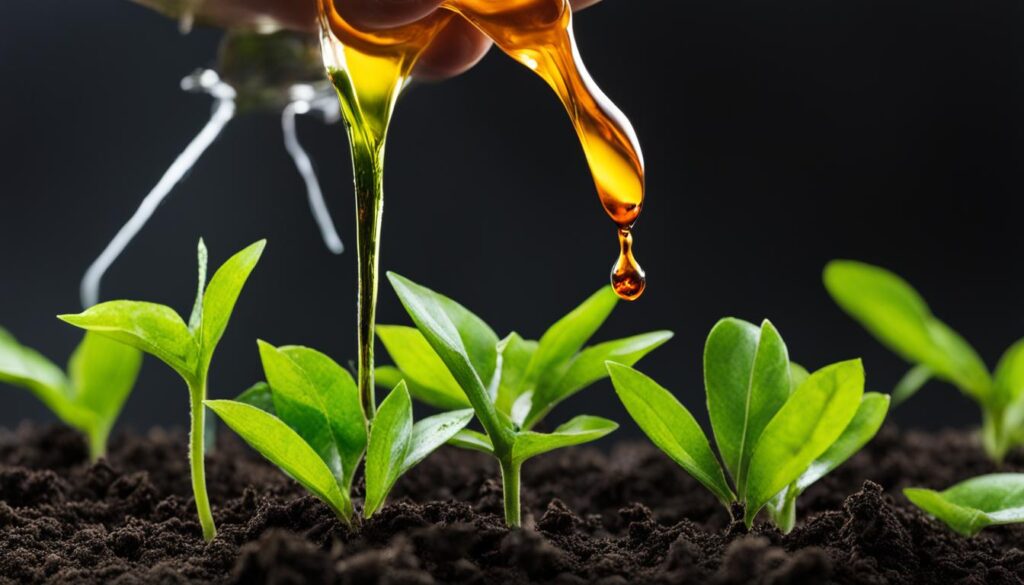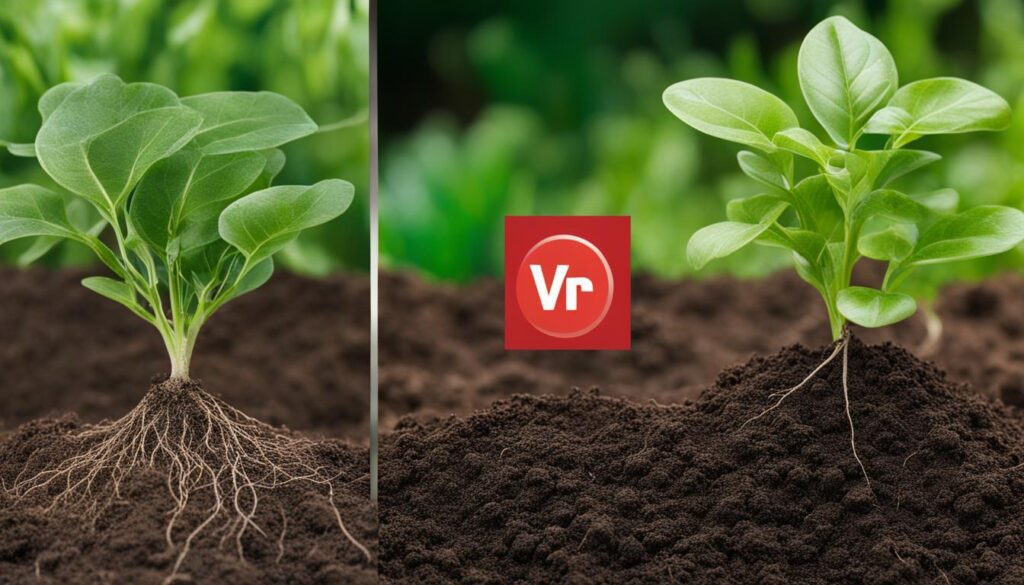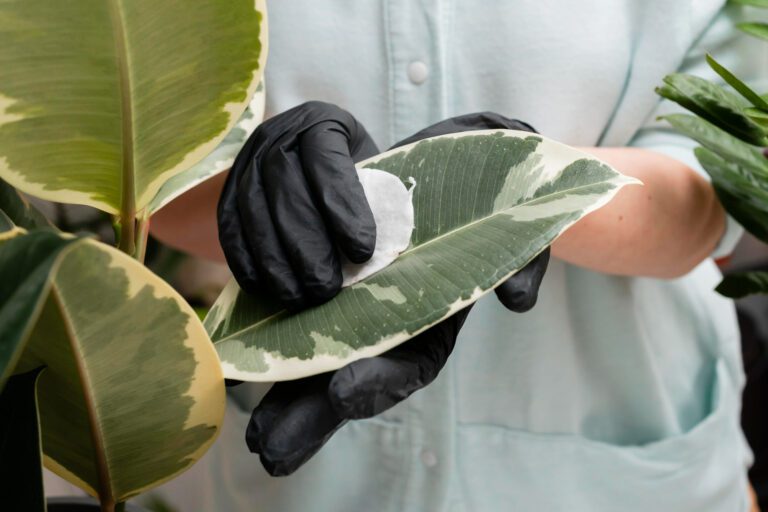
Are your plants looking dull and lackluster? They might be suffering from iron deficiency. Iron is a vital micronutrient that plants need for healthy growth and development. When plants lack iron, essential functions like chlorophyll production and energy transfer are compromised, leading to stunted growth and poor overall health.
In this article, I will guide you on how to effectively treat iron deficiency in plants and restore their vibrant green color. From understanding the role of iron in plant health to diagnosing and preventing deficiencies, we will cover everything you need to know to keep your plants thriving.
Key Takeaways:
- Iron is a crucial micronutrient for plant health and development.
- Monitor your plants for early symptoms of iron deficiency.
- Soil pH plays a significant role in iron availability.
- Prevention is key: maintain proper soil pH and provide adequate water drainage.
- Effective treatment options include applying iron supplements and adjusting soil pH.
The role of iron in plant health
Iron (Fe) plays a crucial role in the overall health and well-being of plants. Similar to its function in the human bloodstream, iron assists in transporting oxygen throughout a plant’s circulatory system.
It is also essential for the formation of chlorophyll, the pigment responsible for photosynthesis and the characteristic green color of plants. As a micronutrient, plants require iron in smaller amounts compared to macronutrients. Its significance cannot be undermined, as iron deficiency can severely hinder plant growth and development.
Iron deficiency in plants manifests in several symptoms. The most noticeable sign is leaf chlorosis, which refers to the yellowing of plant leaves while the veins remain green.
In more severe cases, the leaves may turn yellow or even white. Other symptoms include stunted growth, inhibited flowering, and the presence of necrotic spots on leaves.
Several factors can contribute to iron deficiency in plants, including high soil pH (above 6.5), excess levels of manganese, copper, or zinc, over or underwatering, poor root function, and inadequate oxygen supply in the roots.
Understanding the causes and symptoms of iron deficiency is vital for its prevention and treatment. By maintaining optimal soil pH levels, providing adequate drainage, and ensuring a healthy root system, plants can better absorb and utilize iron.
Regular monitoring and early intervention can help identify and address iron deficiency issues promptly. Additionally, incorporating iron-rich fertilizers or soil amendments can supplement iron levels in the soil and promote healthier plant growth.
| Cause | Symptoms |
|---|---|
| High soil pH (above 6.5) | Leaf chlorosis, stunted growth, inhibited flowering |
| Excess manganese, copper, or zinc | Leaf chlorosis, poor growth |
| Over or underwatering | Leaf chlorosis, poor growth |
| Poor root function and oxygen supply | Leaf chlorosis, necrotic spots |
Iron is a vital micronutrient for plant health, contributing to oxygen transportation and chlorophyll formation. Iron deficiency in plants can lead to various symptoms, including leaf chlorosis, stunted growth, and poor flowering.
Factors such as high soil pH, excess levels of certain minerals, improper watering, and root function can contribute to iron deficiency.
Preventing iron deficiency involves maintaining optimal soil pH, providing adequate drainage, and ensuring a healthy root system. Applying iron-rich fertilizers or soil amendments can also help address iron deficiency in plants.
Diagnosing and Preventing Iron Deficiency in Plants
To ensure the optimal health and productivity of your plants, it is crucial to diagnose and prevent iron deficiency. Diagnosing iron deficiency can be done by observing symptoms such as chlorosis (yellowing of leaves) and poor growth. But, it’s important to distinguish iron deficiency from other nutrient deficiencies that may exhibit similar symptoms.
One effective method is to conduct a soil test to determine the pH levels and iron availability. Higher soil pH levels, especially above 6.5, can lead to iron deficiencies. In alkaline soils, iron becomes less soluble and less accessible to plants.
Calcium carbonate (CaCO3) deposits in high pH desert soils can contribute to iron deficiency. By lowering soil pH through soil amendments or acidification, you can improve iron availability and prevent deficiency.
Prevention is key when it comes to iron deficiency in plants. Maintaining proper soil pH levels, providing adequate water drainage, avoiding overwatering, and ensuring a healthy root system are essential steps.
Adding organic matter to the soil can increase its iron-holding capacity, while using iron-rich fertilizers or amendments can provide a longer-lasting solution. Regular monitoring of plant health and implementing preventive measures can help avoid iron deficiency and promote optimal plant nutrition.
- Diagnose iron deficiency by observing symptoms and conducting soil tests.
- Lower soil pH to improve iron availability.
- Prevent iron deficiency by maintaining proper soil pH, drainage, and root health.
- Use organic matter and iron-rich fertilizers to enhance iron uptake in plants.
| Diagnosing Iron Deficiency | Preventing Iron Deficiency |
|---|---|
| Observe symptoms such as chlorosis and poor growth | Maintain proper soil pH levels |
| Conduct soil tests to determine pH and iron availability | Provide adequate water drainage |
| Distinguish iron deficiency from other nutrient deficiencies | Avoid overwatering |
| Ensure a healthy root system | |
| Add organic matter to the soil | |
| Use iron-rich fertilizers or amendments |
Treating iron deficiency in plants

When it comes to treating iron deficiency in plants, there are several effective options available. One convenient method is to apply liquid iron directly onto the plant foliage. This provides a quick boost of iron and is a short-term fix for the deficiency.
Another approach is to use powdered or granulated chelated iron, which can be applied to the soil around the root zone. This helps correct pH imbalances and provides a longer-lasting iron solution. It’s important to follow the package instructions for application rates to ensure proper treatment.
When using iron supplements, it’s crucial to avoid fertilizers that contain phosphorus, as this can further contribute to chlorosis. Continuous monitoring of the plants is necessary, and regular applications of iron supplements may be required to maintain adequate iron levels.
Treatment options for iron deficiency in plants:
- Apply liquid iron directly onto the plant foliage for a quick boost
- Use powdered or granulated chelated iron around the root zone for longer-lasting treatment
- Avoid fertilizers containing phosphorus to prevent chlorosis
- Monitor plants regularly and provide ongoing iron supplementation as needed
By implementing these treatment options, you can effectively address iron deficiency in your plants and promote healthier growth.
Remember to carefully follow the instructions provided with the iron supplements and monitor your plants to ensure they receive the necessary nutrients for optimal development.
| Treatment Options | Benefits |
|---|---|
| Application of liquid iron onto foliage | Provides a quick boost of iron |
| Use of powdered or granulated chelated iron around the root zone | Corrects pH imbalances and offers longer-lasting treatment |
| Avoidance of fertilizers containing phosphorus | Prevents chlorosis and further nutrient imbalances |
| Regular monitoring and supplementation | Maintains adequate iron levels for optimal plant growth |
Soil pH and Iron Deficiency
The pH level of the soil plays a crucial role in the availability of iron to plants. When the soil pH is too high, especially above 6.5, it can lead to iron deficiencies in plants. In alkaline soils with pH levels above 7, iron becomes less soluble and less accessible to plants. This can have detrimental effects on the overall health and growth of plants.
One of the main causes of iron deficiency in plants is the presence of calcium carbonate (CaCO3) deposits in high pH desert soils. These deposits can contribute to reduced iron availability.
Overwatering plants in calcareous soils can further exacerbate iron deficiency. It is therefore important to monitor soil pH levels and take appropriate measures to improve iron availability to plants.
Lowering the soil pH is one effective way to enhance iron uptake in plants. Acidifying the soil or using iron fertilizers can help adjust the pH level and make iron more accessible to plant roots.
Conducting a soil test to determine the pH levels and iron content is crucial for implementing an appropriate treatment plan.
Table: Soil pH and Iron Availability
| Soil pH Level | Iron Availability |
|---|---|
| Below 6.5 | Optimal iron availability |
| Around 6.5 | Iron availability begins to decrease |
| Above 7 | Iron becomes less soluble and less accessible to plants |
By understanding the relationship between soil pH and iron deficiency, gardeners and plant enthusiasts can take the necessary steps to prevent and address iron deficiencies in their plants.
Maintaining optimal soil pH levels, providing proper drainage to avoid waterlogging, and utilizing iron-rich fertilizers or soil amendments can all help improve iron availability and ensure healthy plant growth.
Good sources of iron for plants

When it comes to treating iron deficiency in plants, it’s important to provide them with good sources of iron. These sources can help improve iron uptake and ensure optimal iron levels in your plants. Here are some effective options:
- Liquid iron: Liquid iron, such as iron sulfate or chelated iron, can be sprayed directly on the plant foliage. This provides a quick boost of iron and is a convenient option for fast results.
- Powdered or granulated chelated iron: These iron sources can be applied to the soil around the root zone. They help correct pH imbalances and provide a longer-lasting iron solution, ensuring sustained iron availability for your plants.
- Iron-rich fertilizers or soil amendments: Choose fertilizers or amendments that are rich in iron. These can be added to the soil to enhance its iron content and improve iron uptake by the plants.
It’s essential to choose iron sources that are suitable for your specific plants and follow the package instructions for application rates. Regular application of these iron sources can help maintain optimal iron levels and promote healthier plant growth.
Remember, iron deficiency in plants can have a significant impact on their overall health and productivity. By providing them with the right sources of iron, you can ensure they have the necessary nutrients for proper growth and development.
Avoiding iron deficiency in plants
When it comes to maintaining healthy plants, preventing iron deficiency is key. By taking a few simple steps, you can ensure that your plants have sufficient iron levels and thrive in your garden. Here are some effective strategies for avoiding iron deficiency in plants.
1. Choose iron-rich plant varieties: Selecting plant varieties that are known to have higher iron uptake can be a great way to prevent deficiencies. Look for plants that are naturally more resistant to iron deficiency or seek advice from local nurseries and gardening experts.
2. Maintain proper soil pH levels: Keeping your soil pH within the optimal range is crucial for iron availability. Test your soil regularly and make adjustments if necessary. Lowering the pH can be done by adding organic matter or using specific soil amendments that help increase iron absorption.
3. Provide adequate drainage and avoid overwatering: Proper water drainage is essential to prevent waterlogging, which can inhibit iron uptake in plants. Ensure that your plants’ roots have adequate access to oxygen by avoiding overwatering or improving drainage in heavy clay soils.
4. Regular plant care and monitoring: Regularly inspect your plants for any signs of iron deficiency, such as yellowing leaves with green veins or poor growth. Address any issues promptly by implementing appropriate treatments, such as using iron supplements or adjusting soil pH.
By incorporating these preventive measures into your gardening routine, you can help avoid iron deficiency in your plants and promote healthier growth. Remember, a proactive approach is always better than trying to fix deficiencies later on. Happy gardening!
FAQ
What are the symptoms of iron deficiency in plants?
The symptoms of iron deficiency in plants include leaf chlorosis (yellowing of plant leaves with green veins), yellow leaves occasionally turning white if worsened, signs of necrosis where flowering and plant growth is inhibited, poor growth and leaf loss, intense yellowing on the young leaves, and growth shoots between veins.
What causes iron deficiency in plants?
Possible causes of iron deficiency in plants include high soil pH (above 6.5), excess of manganese, copper, or zinc, over or underwatering plants, soil with too much clay or too wet causing oxygen supply issues in roots, too much phosphorus in the substrate, low root temperature, root system not functioning effectively, and too much light promoting algae growth which uses up iron.
How can I diagnose iron deficiency in plants?
Iron deficiency in plants can be diagnosed by observing symptoms of chlorosis and poor growth. Soil testing can also provide valuable information on pH levels and iron availability.
How can I prevent iron deficiency in plants?
To prevent iron deficiency in plants, maintain proper soil pH levels, provide adequate water drainage, avoid overwatering, and ensure the root system is healthy and functioning effectively. Adding organic matter to the soil, using iron-rich fertilizers or soil amendments, and practicing proper watering techniques can also improve iron uptake.
How can I treat iron deficiency in plants?
Treatment options for iron deficiency in plants include applying liquid iron directly onto the plant foliage, applying powdered or granulated chelated iron to the soil, and ensuring the root system is healthy. Regular monitoring and application may be necessary to maintain adequate iron levels.
How does soil pH affect iron availability to plants?
Higher soil pH levels, especially above 6.5, can result in iron deficiencies in plants. Lowering soil pH by acidifying the soil or using iron fertilizers can help improve iron availability.
What are some good sources of iron for plants?
Good sources of iron for plants include liquid iron (iron sulfate or chelated iron) that can be sprayed directly on the plant foliage, and powdered or granulated chelated iron that can be applied to the soil. These iron sources can help improve iron uptake and maintain optimal iron levels in plants.
How can I avoid iron deficiency in plants?
To avoid iron deficiency in plants, choose plant varieties that are less susceptible to iron deficiency, maintain proper soil pH levels, provide adequate drainage, avoid overwatering, and regularly monitor plant health and nutrition. Consulting plant-specific guides and conducting soil tests can also be helpful.






